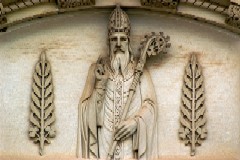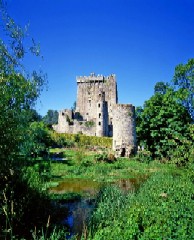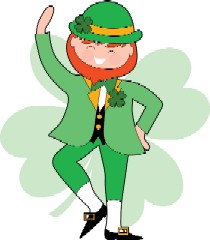Saint Patrick
in Holidays Trivia, Irish Trivia No Comments » Born in Scotland, at Kilpatrick, Saint Patrick is the patron saint of Ireland. His exact birth date is unknown. However, it is believed that he was born sometime around the year 385 AD and died around the year 460 AD.
Born in Scotland, at Kilpatrick, Saint Patrick is the patron saint of Ireland. His exact birth date is unknown. However, it is believed that he was born sometime around the year 385 AD and died around the year 460 AD.
Born to wealthy parents, Calphurnius and Conchessa, Patrick lived among the wealthy and high ranking families. Irish intruders at his father’s home took prisoner Saint Patrick at the age of sixteen. He was taken to Ireland where he was sold as a slave. He spent the next six years as a captive in Ireland.
He spent much of this time tending the flocks of his master in solitude in the valley of the Braid. He became lonely and afraid and turned to God and religion for comfort, praying several times throughout his day. During this time, he learned the Celtic tongue fluently. He also learned of the rituals of Druidism, since his master was a druidical high priest.
Read the rest of this entry »
 The Blarney Stone may exist in Ireland in the village of Blarney, but people the world over know of its existence and its intriguing reputation. It has been said, and believed by many, that whoever kisses the blarney stone will be blessed with the gift of gab, a silver tongue if you will. The gift of gab is also known as the eternal gift of eloquence, which is known as solabharthact in the Irish tongue.
The Blarney Stone may exist in Ireland in the village of Blarney, but people the world over know of its existence and its intriguing reputation. It has been said, and believed by many, that whoever kisses the blarney stone will be blessed with the gift of gab, a silver tongue if you will. The gift of gab is also known as the eternal gift of eloquence, which is known as solabharthact in the Irish tongue. Leprechauns, small in stature and dressed in green, are also thought to be the guardians of an ancient treasure. Perhaps the Danes left the treasure when they were passing through Ireland long ago. In fact, some believe they may have buried the treasure in crocks or pots, hence the tales of crocks of gold.
Leprechauns, small in stature and dressed in green, are also thought to be the guardians of an ancient treasure. Perhaps the Danes left the treasure when they were passing through Ireland long ago. In fact, some believe they may have buried the treasure in crocks or pots, hence the tales of crocks of gold.